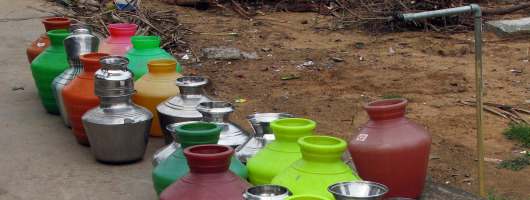Here are 3 quick but sobering facts about the present world water situation: Water insecurity could increase malnutrition in 75-125 million people by 2080. Diarrhea caused by unclean water kills five times as many children as HIV/AIDS. In some areas, the amount of available water can fall below 1/10th the basic human requirement.1 The good news is that there is an organization with a lot of clout behind it working to change those facts, and give people universal access to clean water and sanitation: Global Water Challenge.

Global Water Challenge (GWC), a coalition of 22 leading organizations from around the world, is taking the lead to create a global movement in water and sanitation issues. The idea for GWC grew out of a series of forums held by the Global Environment & Technology Foundation (GETF) throughout 2005 and early 2006. The GWC was initially funded by the United Nations Foundation, Dow Chemical Company, Coca-Cola, Cargill, and the Wallace Genetic Foundation, and was launched in 2006.
The very first project of the GWC was begun in 2006 in the Nyanza Province of Kenya. The aim was to provide comprehensive coverage for water, sanitation and hygiene education in 1,500 schools, in cooperation with the Kenyan government. Seed funding came from the Coca-Cola Foundation, and the Bill and Melinda Gates Foundation added an additional $9.5 million to that original amount. Monitoring and evaluation of the project is handled by Emory University, and the Centers for Disease Control (CDC) is documenting both the benefits and the challenges for the communities, students, and teachers.
GWC has many other projects in the works right now, including:
- Manna Energy Foundation is installing close to 500 water treatment systems, biogas generators, and high efficiency cook stoves for secondary schools in Rwanda. Manna will fund the venture with carbon credits generated by saving fuel wood.
- Naandi Foundation: Community-based Safe Drinking Water Systems – Naandi focuses on three areas: child rights, safe drinking water, and sustainable livelihoods. Begun with a single pilot project in 2005, Naandi now has over 150 operational water purification plants and 200 plants in various stages of construction in Andhra Pradesh and Punjab. When all 350 water plants are completed, over 1.75 million people will benefit from them.
- Water, Sanitation and Hygiene Education in Rural Schools: Puebla, Guerrero, Chiapas, and Oaxaca Mexico – These projects seek to raise the awareness of problems associated with water, sanitation, and inadequate hygiene to the school communities through diverse activities of monitoring, assessment, education, and communication and training in ecological sanitation.
These are just a few of the projects from GWC. For a full list, see the GWC Project Page.
GWC has three main criteria for their projects: They all must be sustainable, replicable, and scalable.
Sustainable: All projects must have plans for long-term. Sustainable projects maintain the local water source and build local capacity in order to maintain and operate a water system. This requires the involvement of the local community, local government, and local businesses, For each system that doesn’t have to be replaced, more resources will be available in the future for new projects.
Replicable: GWC measures impacts and benefits consistently, communicating these clearly throughout the project. Monitoring programs and sharing information helps communities, governments, local entrepreneurs, and non-profits working in this sector. Having access to results allows leaders in the field to replicate the program on their own.
Scaleable: GWC invests in successful models with the potential to expand beyond a particular area. These models should be flexible enough to meet the demands of individual localities.
For more about Global Water Challenge, or to make a donation (100% goes to GWC projects), see the GWC website. If you’re on Facebook, check out the GWC Cause there.
1Global Water Challenge

You must be logged in to post a comment.